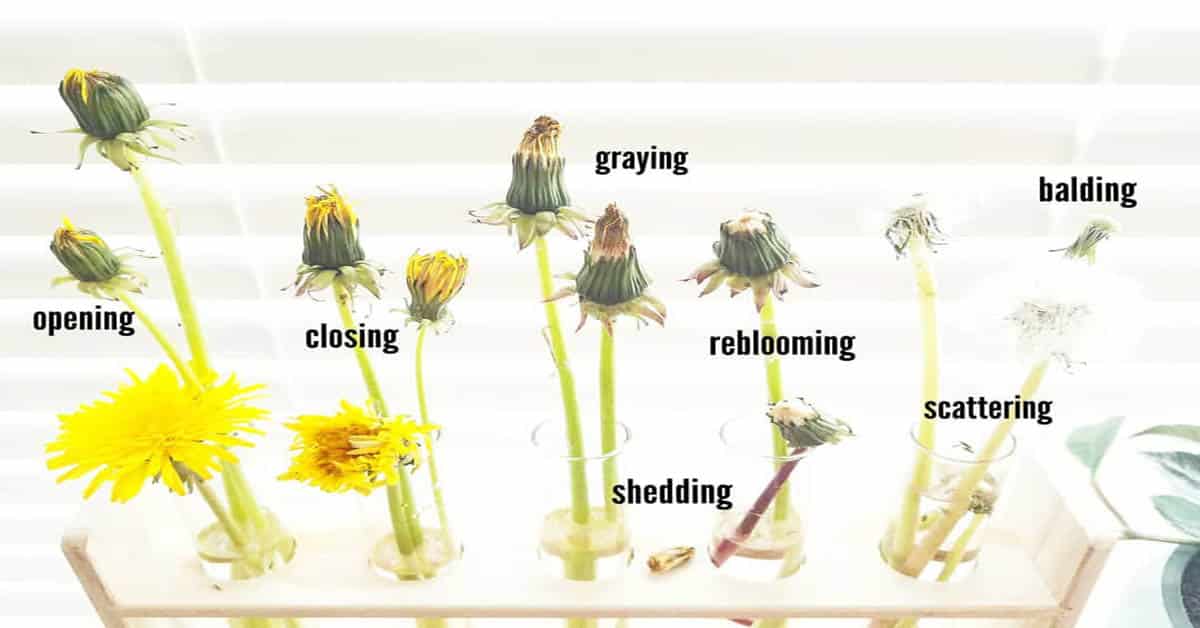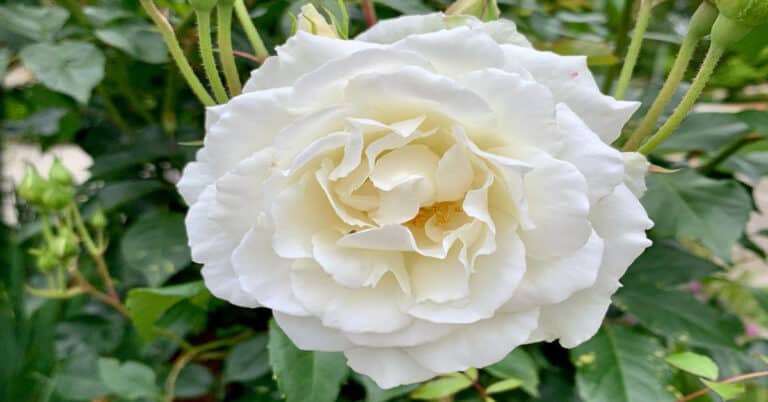Dandelion Life Cycle – Stages & Interesting Facts You Didn’t Know
Do you have any childhood memories of these adorable flowers? We all enjoyed tinkering and wishing with dandelion seeds! Even today, many individuals still perform a practice that involves blowing dandelion seeds to make wishes.
Have you ever looked up information about the dandelion life cycle, though? How it turns into a lovely flower from a seed and then ends up in our hands to grant wishes must be fascinating.
Get comfortable learning more about the dandelion life cycle as we discuss the stages of the dandelion life cycle and how these incredible plants develop and reproduce.
General Information About Dandelion
The name “Dandelion” is interestingly derived from the French phrase “dent de lion,” which refers to the plant’s leaves’ teeth-like serrations and means “lion’s tooth.” An herbaceous perennial known as a dandelion grows from a big, unbranched tap root. The deeply serrated leaves are basal, which means they don’t rise on stems but instead appear at ground level from the plant’s crown.
Have you seen the brilliant yellow blossoms growing on the hollow stalks? The flower head is a queen of numerous little florets, typical of the entire Asteraceae plant family.
Dandelion seeds have the potential to create a somewhat durable seed bank. The half-life of the seed in the soil is three months. A few seeds that were buried may still be alive after five years. Storage of seeds at 27°C and 80% humidity kills them.
The Reproduction
Before we discuss the dandelion life cycle, let’s first take a look at the plant’s reproduction. Dandelions have a single tap root and are vegetative plants that develop from seeds. They do not spread sexually by stolons or runners. But they can undergo asexual seed reproduction.
Even tiny portions of root left over when plants are torn up may regenerate, but bigger sections of root do so more successfully than thin ones. The interesting thing is that fragments’ orientation can affect their chances of surviving, and their regeneration can be significantly impacted by the season.
The reproduction process strongly depends on the wind conditions that disperse dandelion seeds, which can move up to 500 meters from the parent plant. Irrigation water has been used to recover seeds that can withstand submersion for nine months.
Origin Of Dandelions
Although they originated in Eurasia, dandelions have now spread to other parts of the world, including North America, South America, India, Australia, New Zealand, and possibly everywhere else that Europeans, the people, have immigrated.
Interestingly, it’s believed that this species was introduced to North America because individuals wanted a flower that brought back memories of their former homeland and because it had medical uses. Because of its fast-spreading ability, the dandelion soon became an important part of the local flora.
Dandelion Life Cycle
Let’s now take a look at the dandelion life cycle. Dandelions can rebloom in the fall but tend to flower most often in the spring. Therefore, the dandelion life cycle has one of the most special characteristics among all plants.
The dandelion life cycle generally consists of five main stages. Specifically, it starts with the seed head developing, seed growing, dispersing seeds by the wind, plant, plant flowering, and all over again.
In order to understand the life stages of this plant, it’s important to have general ideas about the symbolism of the dandelion. The truth is that some people believe that dandelions are the only flower that, at various stages of their life cycle, represents the sun, moon, and stars. The dandelion plant’s puffy ball resembles the moon, while its puffy yellow blossom and scattering seeds represent the sun and stars, respectively.
The Beginning of the Dandelion Life Cycle
The dandelion life cycle begins at the seed stage. The wind disperses the dandelion seeds. The seed will begin to sprout and spread all along the field when the conditions are right. The roots must delve into the earth for growth.
A seed focuses on its growth during germination by developing a deep tap root and a rosette of small leaves close to the earth. Dandelions appear to be difficult to remove from your garden because they have already spread by the time you notice them. Always keep in mind that a fresh generation of dandelions is always on the horizon when attempting to eradicate them.
Flower Phase
After the seed stage, the dandelion life cycle moves to the flowering stage, where it turns into a beautiful yellow flower. The dandelion life cycle continues with a young plant popping its head through the ground in search of sunlight.
The plant will get stronger as it takes nutrients from the soil and has enough minerals to grow. Buds and leaves will begin to sprout. Then the dandelion plant’s vibrant blossoms will start to bloom. If you take a walk in a garden and see yellow or orange flowers in hue, there’s a high possibility that they are dandelions.
Like many other plant species, dandelions also love the sun! That’s why they often bloom in the morning and close at night. The seeds grow inside the closed head after they have been in the flower for a few days, and the transition to the next stage of the dandelion life cycle begins.
Cypselae
Each seed of the dandelion, which is technically a fruit and is referred to as a “cypselae,” is generated on the flower stem and corresponds to one of the florets in the flower head. Each bears a pappus, a group of feathery bristles that function as a parachute or sail to ensure that the wind disperses the seed.
This is where we would pick all the dandelions to make wishes. The flower stalk gradually lengthens as the seeds mature, lifting the fluffy seed head into the breeze. A spread seed generates a rosette of tiny leaves near the ground’s surface, developing a deep tap root. And the dandelion life cycle starts all over again.
Most likely, you’ve seen one, but the seed head is still shaped like a puffy, white ball of seeds, so be careful with the kids; they will try to eat it. Finally, the new seeds will become dandelion plants if they can find suitable soil to grow in.
Controlling Dandelions Spread
Everyone who has a garden knows how disturbing dandelions can be since dandelions are plants that produce huge amounts of seeds that fly all around your yard. If you want to get rid of dandelions from your garden, you should know it won’t be easy.
You should consider the following advice:
- Your lawn shouldn’t be cut too short! Never cut the grass shorter than 5 cm or more than one-third of the length of the blade at once. By mowing your lawn, you offer dandelions more room to grow.
- Use no fertilizers! Grass absorbs nutrients less effectively than weeds like dandelions. You can encourage the growth of clovers and other plants by applying organic nitrogen fertilizer to the grass.
Why Should We Control the Dandelion Seeds?
Dandelions damage the ground, even though they may appear quite harmless. They were among the first weeds to establish themselves on disturbed terrain where other plants couldn’t.
They undoubtedly thrive with dirt and sun, but their strong roots can penetrate even the toughest soil, and you will frequently find them growing through concrete, which irritates grass purists.
Interesting Facts About Dandelions
- Did you know that dandelions can live for 10 to 13 years on their own in untouched areas?
- Dandelion seeds can travel up to five kilometers from their original location.
- Various insect species pollinate dandelions. The plant’s yellow blossom develops into a puffball that contains several fruits called achenes. A disk-shaped extension on dandelion seeds acts as a parachute and aids in wind dissemination.
- It’s a common belief that you can make a wish on a dandelion by choosing one, holding it in your hand, and making a wish while softly blowing on it to release seeds into the air. The half-life of the seed in the soil is three months.
Can You Eat Dandelions?
And finally, let’s answer the most common question about dandelions. Actually, yes, dandelions can be eaten, believe it or not. Did you know that dandelions may be used to make wine? Online, there are many recipes for producing dandelion wine. Or that salads with young leaves are delicious?
Surprisingly, lettuce is a member of the same plant family as dandelions! Additionally, dandelion roots can be used as a substitute for coffee after being cooked and pulverized.
Final Thoughts
We still have fond memories of dandelions from our youth, and even now, the dandelion life cycle significantly impacts the environment. Dandelions are nearly impossible to keep out of your gardens because they spread quickly. They are mostly safe and won’t damage you unless you have allergies. And if that’s the case, you may want to request special assistance to get them removed.

Nato is a content writer and researcher with a background in psychology who’s eager to explore the wonders of nature. As a travel enthusiast and animal lover, she hopes to inspire others to discover and cherish the beauty and importance of the natural world.


